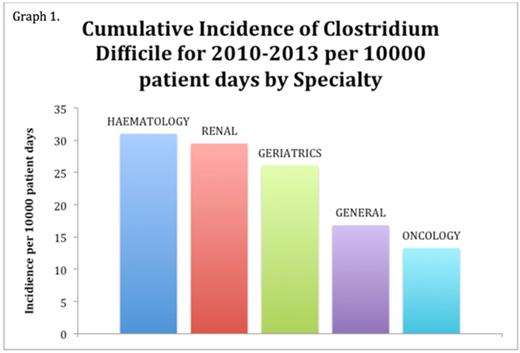Abstract
Background
Clostridium difficile infection (CDI) is an important and increasingly prevalent healthcare-associated infection. Strongly associated with antibiotic exposure, CDI may result in diarrhea, colitis and death-particularly in at-risk patients. While the incidence of both CDI and CDI-associated complications appears more common in hematology patients - the economic impact of CDI in this patient population has not been assessed. We report the results of a hospital-wide audit and case-control study of CDI incidence to assess length-of-stay (LOS).
Methods
Hospital wide CDI incidence was reviewed for the period 2010-2013. Medical records were assessed to determine total patient days per specialty and the incidence of CDI as reported on discharge coding data. Hematology cases had CDI confirmed by reviewing diagnostic samples for PCR or toxin. Clinical data was collected including basic demographics, risk factors and outcomes. Controls drawn from departmental database were matched for age, sex, malignancy and admission reason. Statistical analysis was performed with the primary outcome being length of stay (LOS).
Results
During the period of study hematology patients consistently had the highest incidence of CDI across the hospital. (Cumulative incidence per 10,000 patient days are shown in graph 1.) A case-control study of 79 patients was performed with no significant differences in baseline demographics between groups. The primary outcome of LOS was statistically significant with a mean of 25 days for CDI affected patients compared with 15 days (p = 0.02). Risk factors analysis revealed a trend towards statistical significance for those prescribed a H2 Blocker (RR 1.66 95% CI 1.12-2.45, p = 0.01) but no difference was seen for proton pump inhibitor (PPI) use or antibiotic presence or duration. Analysis of morbidity and mortality demonstrated an increased relative risk of pseudomembranous colitis for those exposed to CDI (RR 2.01, 95% CI 1.72-2.36, p<0.0001), a non-significant increase in GvHD in patients who had undergone allogeneic BMT (56% v 31%; RR 1.65 95%CI 0.82 - 3.32, p = 0.16) but no differences in intensive care admission or mortality.
Discussion
Of hospitalized patients the highest incidence of CDI is in patients with hematological disorders. In these patients CDI had a significant impact on health-care costs - increasing LOS by 10 days, on average, at a cost of $260USD per day. This means that in the three year study period, for hematology patients alone, the additional bed cost resulting from CDI was $630,000USD. The combined medical and economic burden of CDI in patients with hematological disorders is considerable and warrants further study of risk factors for CDI and strategies to reduce CDI infection and its nosocomial spread within hematology units.
Imlay-Gillespie:Novartis: Honoraria. Arthur:BMS: Honoraria; Amgen: Honoraria; Amgen: Honoraria. Mackinlay:Roche: Research Funding; Sanofi Aventis: Research Funding. Mulligan:Celgene: Consultancy, Honoraria; Janssen: Consultancy, Honoraria, Speakers Bureau; Sanofi Aventis: Research Funding; Roche: Consultancy, Honoraria, Research Funding, Speakers Bureau.
Author notes
Asterisk with author names denotes non-ASH members.


